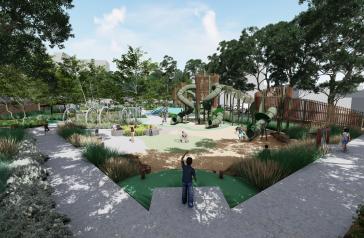Picture yourself standing in a garden. You’re admiring the vibrantly coloured flowers, while the scent of native herbs waft past you on the breeze. You can hear insects buzzing, birds calling and the sound of water trickling nearby, and the textures of the different plants tickle your fingers.
Welcome to the enchanting world of sensory gardens, where nature meets your senses in a symphony of delight.
What is a sensory garden?
Sensory gardens are a kaleidoscope of experiences specifically designed to enage, captivate, and rejuvenate your senses. They’re not your typical flowerbed – they’re a multi-sensory adventure!
 Sensory gardens encourage visitors of all ages and abilities to experience nature close-up.
Sensory gardens encourage visitors of all ages and abilities to experience nature close-up.
The location of a sensory garden, as well as the different types of vegetation planted, are carefully chosen to evoke as many senses as possible. This is so visitors aren’t just looking at nature, but are instead hearing, smelling, touching, and even occasionally tasting, the natural world around them.
These immersive gardens are an educational treasure trove for kids and adults alike. They provide a fun, hands-on opportunity to learn about the diverse world of plants, nature, and ecosystems.
Many sensory gardens are also thoughtfully designed to be inclusive and accessible. This means it doesn’t matter whether you’re young or young at heart, able-bodied or differently abled, sensory gardens offer an inclusive experience for everyone to get close to nature.
In a fast-paced world, sensory gardens act as a little oasis of tranquillity where calming scents and soothing sounds offer a respite from the daily grind. It’s well-known that spending time in nature is good for the soul, and sensory gardens provide the chance to stop and take in the surrounds without venturing too far from home.
Sensory gardens play a small but important role in promoting biodiversity and providing shelter for important pollinators like butterflies and bees. A miniature eco-system can be created with the right sensory garden plantings.
What elements make for a good sensory garden?
To improve biodiversity, aim to use native plants for how each sense is to be engaged. For example, native grasses like kangaroo grass and common tussock grass have interesting textures to feel. Native mint and eucalyptus offer nice fragrances. Wattles and flowering gums create colourful flowers, while ruby saltbush and cherry ballart are good examples of bush tucker that can be eaten.
Careful thought needs to be given to the placement of a sensory garden to capture the sound of being in nature. A trickling stream might be running nearby, or there may be trees nearby for birds to call home and where the wind can rustle through their leaves.








